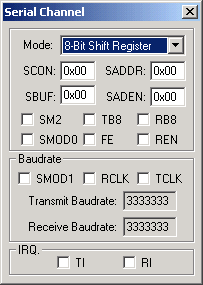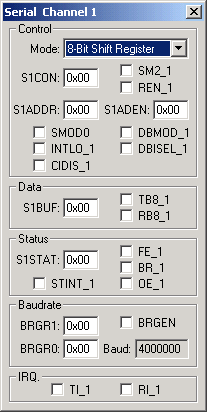|
||
| Products Download Events Support Videos | ||
Product Information
Device Database®
Downloads
Compliance Testing
Distributors
Peripheral Simulation
For NXP (founded by Philips) P89C669 — Serial UART 1 (Enhanced Interface with S1STAT and special BRG without T1,T2)
Simulation support for this peripheral or feature is comprised of:
- Dialog boxes which display and allow you to change peripheral configuration.
- VTREGs (Virtual Target Registers) which support I/O with the peripheral.
These simulation capabilities are described below.
Serial Channel Dialog

Serial Channel #1 Dialog

S1IN VTREG
Data Type: unsigned int
The S1IN VTREG represents the serial input of the simulated microcontroller. Values you assign to S1IN are input to the serial channel. You may assign input using the command window. For example,
S1IN='A'
causes the simulated microcontroller serial input to receive the ASCII character A. If you want to use the S1IN VRTEG to simulate reception of multiple characters, you must be sure to delay for atleast one character time between successive assignments to S1IN. This may be done using a signal function. For example:
signal void send_cat (void) {
swatch(0.01); /* Wait 1/100 seconds */
S1IN='C'; /* Send a C */
swatch(0.01);
S1IN='A';
swatch(0.01);
S1IN='T';
}
You may use the S1IN VTREG to input more than 8 bits of data. For example,
S1IN=0x0123
inputs a 9-bit value. This is useful if you use 9-bit serial I/O. In addition to the S1IN VRTEG, the serial window allows you to input serial characters by simply typing. Serial characters that are transmitted byt the simulated microcontroller appear in the serial window.
S1OUT VTREG
Data Type: unsigned int
The S1OUT VTREG represents the serial output from the simulated microcontroller. Whenever the simulated serial port transmits a character, the value transmitted is automatically assigned to S1OUT (which is read-only). You may read the value of S1OUT to determine the character transmitted by your simulated program. For example,
S1OUT
outputs the value of the last character transmitted. You may use the S1OUT VTREG in a script to process transmitted data. For example,
signal void s1out_sig (void) {
while (1)
{
wwatch(S1OUT); /* wait for something in S1OUT */
printf ("Transmitted a %2.2X\n", (unsigned) S1OUT);
}
}
S1TIME VTREG
Data Type: unsigned char
The S1TIME VTREG allows you to control the timing of the simulated serial port.
- A value of 1 (which is the default) indicates that the serial port timing is identical to the target hardware. Use this value when you want to see the effects of baud rate on the serial port I/O.
- A value of 0 indicates that all serial input and output occur instantaneously. Use this value when you don't care about any baud rate effects or when you want serial output to be fast.
For example:
S1TIME = 0 /* Set Serial Port for FAST timing */ S1TIME = 1 /* Set Serial Port for accurate timing */
ProductsDevelopment Tools |
Hardware & Collateral |
Downloads |
Support |
Contact |
